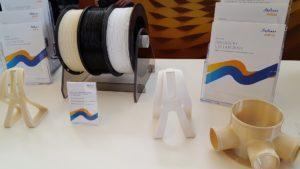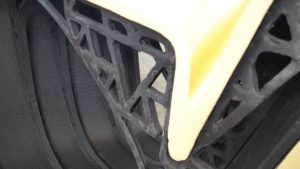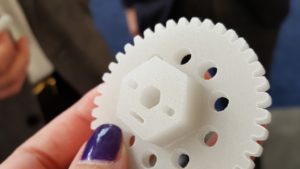 When a big company makes a big commitment to a big technology, it tends to be big news — and SABIC is taking this literally, as the company showcased some big parts last week at RAPID + TCT in Pittsburgh. Sanjay Mishra, PhD, General Manager, Technology & Innovation, and Keith Cox, Senior Business Manager, Additive Manufacturing Specialties, detailed some of the diversified chemical giant’s latest commitments to and announcements in the 3D printing industry as we sat down to talk at the crowded SABIC booth. The two were well-positioned guides in the company, as Mishra is responsible for R&D operations, in which additive manufacturing is currently playing a big role, and Cox is helping to position SABIC in the AM value chain.
When a big company makes a big commitment to a big technology, it tends to be big news — and SABIC is taking this literally, as the company showcased some big parts last week at RAPID + TCT in Pittsburgh. Sanjay Mishra, PhD, General Manager, Technology & Innovation, and Keith Cox, Senior Business Manager, Additive Manufacturing Specialties, detailed some of the diversified chemical giant’s latest commitments to and announcements in the 3D printing industry as we sat down to talk at the crowded SABIC booth. The two were well-positioned guides in the company, as Mishra is responsible for R&D operations, in which additive manufacturing is currently playing a big role, and Cox is helping to position SABIC in the AM value chain.
“We’re really excited to be launching new products,” Mishra told me. “Two to three years back SABIC announced focus and resources in material development to advance additive manufacturing technologies. We have new things that address the gamut of additive manufacturing.”
He referenced new filaments launching that day for FDM, as well as new technology in SLS, and materials for large-scale 3D printing. The common theme, he said, is differentiated and unique offerings with a vision underscoring their line to enable the move from prototyping to real product manufacturing. Cox added that the new materials are intended as part of a refill model for the Stratasys Fortus line, as they are also able to supply the chip for each material canister to be used and identified in a Fortus 3D printer; they not limited to Fortus applications, though, and can be put to use in other 3D printers. The materials intended for large-format 3D printing include eight materials made using four reinforced (with 20% carbon fiber or glass fiber) base resins: ABS, PPE, ULTEM, and polycarbonate. These, Cox said, are a natural fit for large-format, high-strength 3D printing, and process very well.
- RAPID + TCT Show [Photo by Sarah Goehrke for 3DPrint.com]
Examples of 3D printed components at SABIC’s booth provided testimony to the strength of their materials, including detailed impact resistance comparisons.
“Our belief is that for this to truly grow for production, materials need to be there for real product differentiation,” Cox said. “We’re looking at improved impact performance. What we can bring is a very deep expertise in materials gained from other technologies and processes, and a deep application development knowledge. We apply this to additive manufacturing, and what we think it takes for end-use part production, leveraging the unique materials in our portfolio.”
As more materials companies with extensive experience in materials science come toward additive manufacturing, the industry stands to benefit from broad portfolios and expert scientific teams. Chemical companies such as BASF and Evonik, for example, are working in such partnerships as those with HP and Essentium to advance materials development for 3D printing. SABIC has been dipping its toes into the additive manufacturing waters for a few years, and seems ready now to make the leap with its announcements and releases this month.
Showcasing some of the bigness of its announcements at RAPID was a section of a boat hull, as SABIC works with Autodesk toward a new 3D printed yacht project with Livrea Yachts. Created on SABIC’s Big Area Additive Manufacturing (BAAM) machine, the hull section is composed of a carbon fiber-reinforced polyphenelyne ether (PPE) compound, with an inner lattice support structure designed by Autodesk and printed from carbon fiber-reinforced ULTEM PEI compound. The finish was done by partner TruDesign.
“This is a very collaborative effort,” Cox said as we examined the hull section. “That’s the way we like to work on these projects.”
A particular advantage for SABIC as they work on further materials development is in-house: they own the equipment they’re using, like the BAAM. Furthermore, access through the Specialty Compounds business to more than two dozen resins allows for a good starting point for new developments in additive manufacturing, which Cox and Mishra noted as an in-house advantage. This all fits into the company’s work to, as Cox explained, “marry material and process technologies to provide a complete solution.” Working hands-on with technologies and closely with partners are key to SABIC’s plans in moving forward with additive manufacturing.
“We combine material expertise and application development to really collaborate,” Mishra said. “We bring our strengths and look to work with strong partners to reach fuller potential. This is what we believe in.”
The strong focus on partnership and development is shining through as a real growth strategy in 3D printing today as many companies work to leverage their own experience and expertise with partners’ to make the industry as a whole stronger. Discuss in the SABIC forum at 3DPB.com.
[All photos: Sarah Goehrke]
Subscribe to Our Email Newsletter
Stay up-to-date on all the latest news from the 3D printing industry and receive information and offers from third party vendors.
Print Services
Upload your 3D Models and get them printed quickly and efficiently.
You May Also Like
3D Printing News Briefs, July 2, 2025: Copper Alloys, Defense Manufacturing, & More
We’re starting off with metals in today’s 3D Printing News Briefs, as Farsoon has unveiled a large-scale AM solution for copper alloys, and Meltio used its wire-laser metal solution to...
Etsy Design Rule Change Reduces Selection of 3D Printed Goods
Online marketplace Etsy has implemented a rule change requiring all 3D printed goods on the site to be original designs. The update to the site’s Creativity Standards states, ¨Items produced using...
Siraya Tech Introduces New Elastomer 3D Printing Materials, Including Foaming TPU
California company Siraya Tech, founded in 2019 with a focus on material science, customer focus, and agility, develops high-quality 3D printing materials that meet the needs of creators, hobbyists, and...
3D Printing News Briefs, April 12, 2025: RAPID Roundup
The news from last week’s RAPID+TCT in Detroit just keeps on coming! That’s why today’s 3D Printing News Briefs is another RAPID Roundup of more exciting announcements from the trade...










































